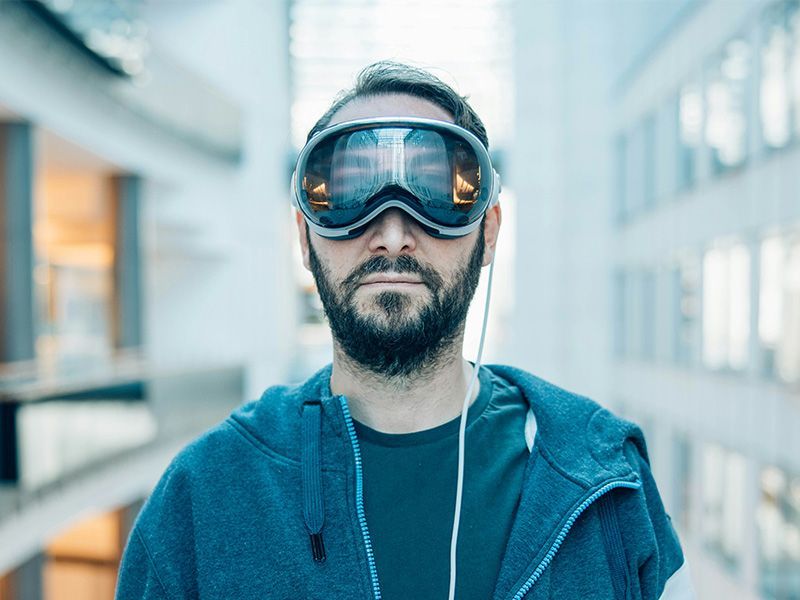Future of Retail: How Edge Compute will Help Create a 24/7 Augmented Retail Experience
Edge computing, 5G, IoT and AI are contributing to a paradigm shift in retail that will imagine new possibilities made commercially viable by real-time data processing.
In this article, we look at the convergence of these technologies and how they will offer a radical new vision of our high street by offering customers exciting new experiences that can rejuvenate in-store shopping and retail spaces.
First, in Part 1, we look briefly at each technology and discuss the technical advantages they offer and how this supports new types of customer experience. Then in Part 2 we look at industry predictions about how the retail space might evolve over the next decade.
Part I
Edge Computing
Edge computing involves processing data near its source rather than in a centralised location. In retail, this means deploying IT infrastructure in or near store venues where consumers interact with products. This ecosystem enables real-time decision-making and personalised customer experiences by analysing data from sensors and IoT devices within the store.
Edge computing is a concept that applies to an integrated network of processing units, data centres and sensors that handle data close to the user.
Micro Data Centres
The compute part of edge computing needs to be housed in proper data centre facilities, to ensure that the expensive server equipment, especially those used by AI systems, are kept in the optimum conditions — this helps keep maintenance and operational costs down. Even though edge compute systems can be relatively compact, retailers will mostly be unwilling to give up valuable floor space for the IT equipment and its associated infrastructure (like cooling and electrical systems), so the more likely scenario is that smaller data centres will be used that can be located close by but in back-of-house areas, such as loading bays, car parks, warehouse areas and so on. These will often be operated as cloud services so that multiple retailers can benefit from edge compute without having to bear the upfront capital cost, and, most importantly, the ongoing maintenance required to keep them operational.
5G
5G networks offer high-speed connectivity and low latency, which are crucial for supporting advanced retail technologies like augmented reality (AR) and Internet of Things (IoT) applications. The increased bandwidth allows for seamless integration of online and offline shopping experiences, enabling features like virtual try-ons and real-time product comparisons.
This connectivity supports personalised marketing strategies that take place in real time and deliver targeted promotions in store.
Internet of Things (IoT)
The Internet of Things (IoT) refers to a network of interconnected devices, machines, and sensors that collect, store, and transfer data over the internet. These devices are embedded with sensors, software, and network connectivity, allowing them to communicate with each other and with other internet-enabled systems.
IoT plays a crucial role in enhancing the retail experience by providing real-time data on customer behaviours, security risks, buying preferences, inventory supply levels and daily operations. IoT devices will principally include cameras but also a range of other sensors such as RFID tags and smart shelves.

Part II
Now we will look at the new possibilities for customer experiences that will be possible due to on-site edge computing and 5G networks.
Omnichannel Shopping Experience
Edge compute, 5G and IoT will evolve together rapidly in the next decade to deliver a new model for the retail experience, one that seamlessly combines our online shopping with the physical environment and also blends the sale of both physical and digital products.
Stores will create Retail Media Networks (RMNs) that share customer data to offer personalised ads that bridge in-store digital platforms, social media, websites and apps, and other media channels. Customers will be able to buy the products they see online, in films and TV series, and pretty much anywhere else.
These networks are projected to account for $231 billion in digital marketing spending by 2030, according to Criteo, and are becoming increasingly vital as economic pressures and thinning profit margins push retailers to diversify their income sources. By enabling brands to reach highly targeted audiences at the point of purchase, RMNs are predicted to enhance the effectiveness of advertising and drive higher returns.
Experiential Spaces
Experiential spaces will replace product shelves to create a boardwalk-like environment focused on immersive experiences. This area will feature recreational areas and in-store concepts designed to enhance customer engagement, foster brand loyalty, and increase the lifetime value of each customer. This mirrors a broader trend of physical stores becoming more like experiential hubs, offering workshops, events, and installations to engage customers on a deeper level and offer community-first brand experiences that cannot be duplicated online.
Personalised Journeys with Agentic AI
Agentic AI is set to redefine the retail landscape by introducing autonomous systems capable of managing entire shopping journeys, from product discovery to post-purchase support. These AI agents leverage advanced machine learning, real-time data processing, and contextual intelligence to proactively handle tasks like comparing prices, applying discounts, and scheduling deliveries—all with minimal human intervention.
For physical stores, edge computing and Agentic AI will enable retailers to process customer data in real-time, allowing for highly personalised shopping experiences that are delivered by virtual assistants, chatbots and interactive displays. Retail stores will transform into hybrid spaces that blend experiential shopping with digital integration. Retailers may focus on creating immersive environments where AI-curated product recommendations meet tactile experiences, while smaller store footprints serve as fulfillment hubs for online orders.
Virtual Reality (VR) & Augmented Reality (AR)
The low latency provided by 5G and edge computing will power seamless AR and VR experiences in retail environments. Customers could virtually try on clothes, visualise furniture at home, or interact with products in immersive environments, all without lag or disruption. This also allows for online gaming in store, with shoppers completing short games, treasure hunts or quizzes to gain instant promotions.
Augmented reality will also be able to guide and influence shoppers in subtle ways with knowledge of their preferences: adding a gleam to certain shelves or products, decorating aisles with augmented pumpkins for Halloween, or using pop-up 3D ads.
This level of personalisation means that retail spaces become chameleon-like, appearing differently to every shopper, on every visit. Customers roam aisles that react and change to their daily wants and needs. Are you tired today? Then a fresh coffee is rushed to you by a cobot (collaborative robot) who helpfully reminds you of a promotion on one of your favourite product lines.

Accessibility
As well as creating sophisticated marketing strategies, the advent of less obtrusive and affordable smart eyewear will allow AR to solve many simple problems of the physical environment. Floating arrows might pop up to guide us to the checkout or fitting rooms; or efficiently guide us to fire exits in an emergency.
In-store transport might include a range of self-driving carts and or hop-on rides to take us around the store quickly. There are many advantages to persons with disabilities. Virtual assistants, self-guided transport, and the real-time data of IoT will make the shopping experience accessible and safe for all ages and abilities.
Smart Mirrors & Interactive Displays
Edge compute and IoT will support the deployment of smart mirrors and interactive displays in stores. These devices can offer product information, styling suggestions, and even virtual try-ons, enhancing the in-store experience.
Walls and ceilings will be wrapped with continuous screens, creating imaginative play spaces for advertisements, events and promotions. Many brands have already experimented with digital shop windows, allowing artists to unleash their creativity — and this will continue in-store, with sights, sounds and aromas that are interactive and personalised to your needs, wants and mood. This will inevitably bring a new meaning to the phrase ‘comfort shopping’.
Customisation
Eventually, with smaller, more versatile 3D printers and other on-site manufacturing technologies, shoppers will be able to customise products and choose elaborate colour schemes, creating one-off limited-edition items that are printed there-and-then in store. This will be supported by AR/VR try-ons and interactive mirrors, allowing you to visualise your creation and wear it before you buy.
Nike are already experimenting in this direction. Partnering with French AR company SmartPixels at its Paris store, customers can now personalise running shoes by configuring colours on a store tablet and using AR to project these colours onto a white shoe.
Inventory Management
Edge computing will enable real-time inventory tracking and management. Retailers can use IoT sensors and RFID tags to monitor stock levels, automate reordering, and optimise supply chain operations.
Smart shelves are equipped with various technologies such as RFID tags, weight sensors, and cameras that allow for real-time tracking of inventory levels. This technology enables retailers to monitor stock levels continuously, reducing the risk of stockouts and overstock situations. When an item is removed from the shelf, the system automatically updates the inventory records, reordering from suppliers and alerting staff to restock as necessary.
Security & Loss Prevention
Advanced video analytics powered by edge computing and AI will enhance security and loss prevention efforts in retail stores, reducing this deficit for retailers and creating safer spaces for consumers.
AI-powered security cameras will predict suspicious behaviors with remarkable accuracy.
These advanced systems can identify actions such as failing to scan an item, scanning the wrong barcode or SKU, or deliberately ‘fake-scanning’ products at self-checkout stations. By leveraging machine learning, the cameras recognise these anomalies in real time and immediately send alerts to store associates or security teams.
The Evolving Role of Retail Assistants
As physical stores increasingly serve as the tangible face of brand identity, the role of the retail associate has become more essential than ever. No longer confined to traditional tasks, store associates are now at the center of creating seamless, customer-focused experiences. This shift brings new responsibilities, requiring them to adapt quickly to emerging technologies and evolving customer expectations.
The rise of services like curbside pickup has further diversified the role, demanding that associates juggle tasks beyond the sales floor, including order management, personalised customer assistance, and efficient in-store operations. Advanced tools powered by AI will assist store associates meet these demands by offering instant access to product information, recommendations, inventory locations, and more. By equipping associates with IoT-enabled headsets, retailers will enhance productivity, streamline workflows, and enable associates to deliver a new level of customer service.
Challenges & Considerations
While these technologies offer significant benefits, retailers must also address challenges such as:
- Data security and privacy concerns
- Initial investment costs for infrastructure upgrades
- Integration with existing systems and processes
- Staff training and resistance to new technologies
As the retail industry continues to evolve, the integration of edge computing, 5G, and micro data centres will be crucial for businesses looking to stay competitive and meet the growing expectations of digital-first consumers.
The physical retail space will evolve to become more experiential, personalised, and community-oriented, blurring the lines between the online and offline worlds. Stores will serve as hubs for brand engagement, product discovery, and social interaction, offering a curated and highly personalised shopping experience that cannot be replicated online.
Preventing a Growing Digital Divide
Given the significant up-front costs of these technologies, they will be limited initially to the retail giants. They may give big brands an even greater competitive advantage over independent stores, threatening to narrow the variety of the retail experience and contributing to a growing digital divide between urban and rural areas.
The implications go beyond individual businesses to the social fabric of our shopping districts. As technology fuels retail consolidation, we risk losing the diverse, local character that makes high streets vibrant. Some organisations are working to bridge this gap by providing independents access to powerful data and shared resources. For example, distributed edge cloud services are being developed which will help democratise access to the edge and will enable smaller retailers and businesses to take advantage of the next generation of applications.
But without concerted action from technology providers and policymakers, the digital revolution could lead to further homogenisation. It will be up to governments and other local authorities to ensure our high street grows sustainably, meeting the demands of the next generation of consumers while also providing places of community, relaxation and refuge.
Citations & References
[1] https://www.fortunebusinessinsights.com/micro-data-centres-market-104849
[2] https://www.gminsights.com/industry-analysis/micro-data-center-market
[3] https://www.collaborate-it.com/blog/why-the-micro-datacentre-market-is-going-macro
[6] https://www.edgeir.com/service-directory/micro-modular-data-center
[7] https://www.zelladc.com/insights/why-retail-needs-to-buy-into-the-micro-data-centre-revolution/ [
[9] https://www.cognizant.com/us/en/insights/insights-blog/6-game-changing-retail-trends-2025
Contact - Smart City article
Subscribe to our insights
Blog Subscribe













